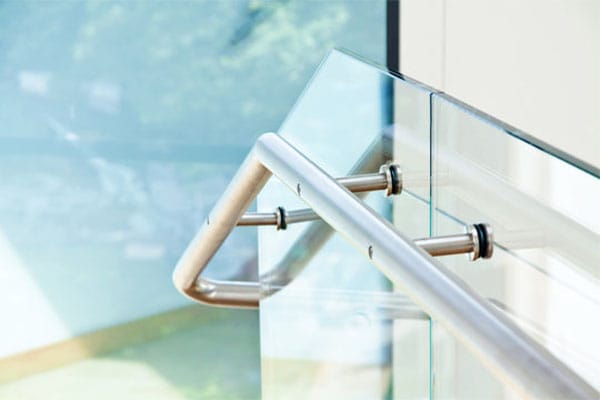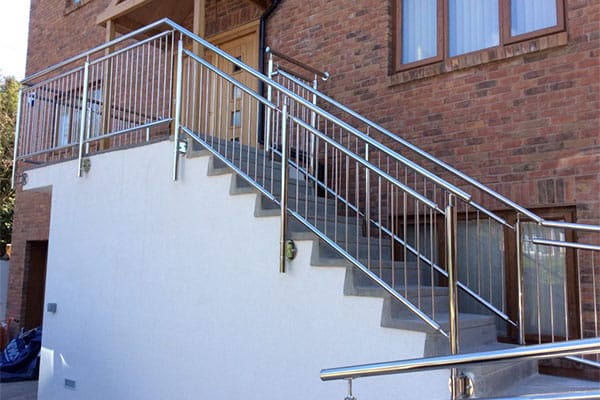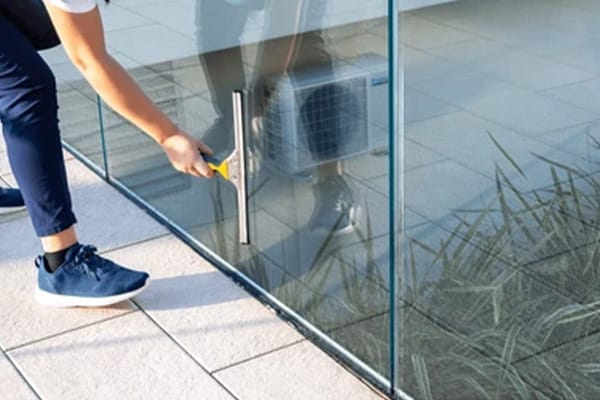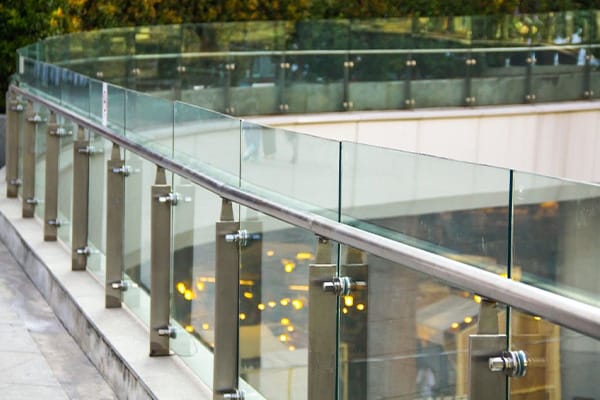

A balustrade does two jobs at once. It stops falls, and it shapes how a room or a terrace feels. When it’s clean, tight and well detailed, you barely notice it. When it isn’t, it draws the eye for the wrong reasons. Cloudy glass on a balcony. Brown streaks on stainless. Timber that has gone grey, splintered and rough to the touch. This guide is a straightforward plan for balustrade maintenance that anyone can follow. It explains why upkeep matters, how glass, stainless steel and wood behave outdoors, and what a sensible routine looks like over a year. The aim is simple: keep the barrier safe, keep the view clear, and avoid the kind of repairs that arrive with scaffolding and a headache. You’ll also find practical glass balustrade care tips that don’t need specialist kit.
Safety comes first. A balustrade is a protective system, not a decorative trim. Small faults hairline splits in sealant, a post that moves when you lean on it, a laminated glass edge that looks milky are early warnings that the barrier is under stress. Water loves a path. If it reaches channels, base plates or fixings and then sits there, it will shorten the life of every part it touches. Regular attention stops small problems turning into a leak after the first big storm or a loose rail at the worst moment.
Comfort is next. Clear glass throws more daylight into a room and makes a terrace feel open. Stainless looks calm and precise when it is clean. Timber under a handrail feels warm when it’s sealed. Leave any of them alone and you get the opposite. Dust and hard-water marks on glass diffuse light and dull a view. Surface blooms on stainless take the edge off a crisp detail. Sun and rain lift fibres on timber, so every touch reminds you something needs doing. A light routine fixes all three.
There is also a money point. Most manufacturers expect reasonable care. If you keep drains clear, rinse salts, wash gently and renew sealants where needed, your warranty is easier to rely on. A quick note on your phone what you did and when can be enough to prove it. That habit often shifts a response from “chargeable repair” to “covered”.
Balustrades are typically made from a few key materials, each with its own advantages and considerations. Understanding their performance outdoors helps you choose the right option.

Glass is the modern favourite because it protects without dividing space. In many frameless balustrade the glass is the structure. Two toughened panes are laminated together around an interlayer. If one pane cracks, the interlayer holds the sheet in place so the barrier keeps working until you can change the panel. Low-iron glass keeps thick edges clear instead of green.
Coatings can help water sheet off. The weakness is not the pane itself but the edges and the details around the edges. Dirt and standing water there can mark a laminate over time. Harsh chemicals can attack sealants. Most “glass problems” are really detail problems.
read more: Best Glass Types for Balustrades

Stainless steel is the quiet workhorse for posts, handrails, base shoes and fixings. It resists corrosion well, but it isn’t magic. In coastal air or around gritted winter roads, salts sit on the surface and hold moisture. That is why you see tea-staining: a light brown bloom that spoils an otherwise sharp line. Grade matters. Indoors, 304 is fine. Outside, especially near the sea or a pool, 316 makes sense. Finish matters too. A brushed finish hides fingerprints and is easier to refresh than a mirror polish.

Wood gives a scheme a human touch. An oak handrail on a glass balustrade makes a staircase feel warmer without adding bulk. Rook and teak stand up well on terraces. The trade-off is weather. UV breaks down pigment and coatings. End grain drinks water unless you seal it. Wood wants a rhythm: clean it lightly, refresh the finish before it fails, and protect cut edges. Treat it that way and it will look better, not worse, as it ages.
read more: Glass Balustrades vs Traditional Railings
Cleaning is where most of the value sits, and it is simpler than you think. The goal is to remove what harms the surface without harming the surface yourself.
For glass that means one sequence, every time. Rinse first so you float grit away. Then wash with a pH-neutral cleaner and a soft cloth or squeegee. Rinse again to remove residue. Dry to stop spots. In hard-water areas, a final pass with de-ionised water keeps the view clearer for longer. Stay away from abrasives and blades. They leave the haze you are trying to avoid. Solvents near the edges are risky because they can attack seals. This is the backbone of sensible glass balustrade care.

Stainless likes a light hand. Start with a rinse to lift salts and dust. Wipe with a mild detergent along the grain. If you can see tea-staining, use a non-abrasive stainless cleaner and rinse well. In exposed places a thin protective film helps. Specialist care liquids or a microcrystalline wax form a barrier so salts don’t cling as easily. Avoid steel wool. It leaves carbon steel fragments that rust and then stain the stainless.
Wood needs its own approach. Dry brush joints and underside edges so leaves and pollen don’t trap moisture. Wash with a mild wood cleaner and a soft brush. Rinse and let it dry. Refresh oil when water stops beading on the surface. If you use varnish, accept that when it fails, you will sand and refinish a wider area, not just touch a corner. Microporous paints are tough if you like a painted look. Whatever you choose, seal end grain as soon as it is exposed. That is where water tries to get in.
Clean little and often. On the coast or next to a main road, rinse monthly and wash each quarter. Inland and sheltered, a quarterly wash is usually enough. After storms, check quickly for trapped debris and move it on. Ten minutes then saves an hour later.
Weather wears things out by being relentless. The first defence is drainage. If water can reach a channel or a base plate, it needs a way to leave. Keep weep holes open. Keep the top of channels free from silt. Don’t run paving, decking or planters hard against the base of a balustrade. A small gap keeps capillary action in check and lets air dry the joint.
Sunlight is the other constant. On south and west edges, UV is stronger and coatings work harder. Plan to refresh timber there sooner. Glass edges dislike long heat and grime together. A small shadow line from a handrail can help, and planting that doesn’t crowd the base helps more. With metals, isolate dissimilar materials. Stainless and galvanised steel in hard contact is a slow fight the stainless will lose. A nylon washer or isolation tape is a cheap fix that prevents galvanic corrosion. Watch the chemistry as well as the weather. De-icers in winter and pool water in summer both contain chlorides. If they reach the balustrade, a quick rinse that day makes a big difference.
Think about where run-off goes. A lovely glass run that spills onto pale stone will leave brown tracks from day one unless the detail sends water somewhere else. A small drip edge, a slight fall away from the wall, or a discreet gutter line takes care of it. These are the quiet moves that keep façades clean.
A short look, twice a year, is enough to keep surprises away. Spring after winter, and autumn before it. Start with feel. Put a hand on the top edge or the handrail and lean gently. A solid system feels solid.
Glass will flex a touch on long spans. A rattle, knock or sudden shift means something needs attention. Work along the base or posts and clear anything that traps water. If you have a dry-glaze channel, look at the wedges. If they have crept or flattened, follow the maker’s instructions for re-tensioning.

Then look close. On glass, scan the edges. A thin white line, tiny bubbles or milkiness are early signs that moisture or cleaners have reached the laminate. It doesn’t mean the panel is unsafe. It does mean the edges deserve care and the seals need a check. Look for chips, especially at corners. Laminated glass usually holds together but a chipped corner on a busy stair should get a professional view.
On stainless, focus on base plates, cover trims and joints. Most blooms polish away if you catch them early. Stains that return point to water traps or dissimilar metals touching. Both have simple fixes.
On wood, press a screwdriver gently into suspect end grain. Softness means moisture has found a path and the piece needs drying, sealing and perhaps a splice. If water no longer beads on the surface, it is time for a refresh even if the colour still looks fine.
Keep a couple of photos on your phone. One today, one next season, from the same spot. You’ll see trends, not guesses. That makes decisions easier: act now, plan for the next dry spell, or leave it alone.
Good balustrade maintenance isn’t a long checklist; it is a few habits you repeat.
If your system is glass-led and you take only one idea from this guide, make it this: glass balustrade care is mostly about timing. Fresh dirt lifts with water. Baked-on grime needs force, and force is what scratches and dulls a view. Keep the edges clean, keep water moving away from the base, and laminated glass will repay you with years of clarity.
And if you are unsure whether a mark is cosmetic or structural, ask. A quick set of photos from inside and out, with a note about the setting coastal, urban, shaded, full sun lets a professional be specific. That short exchange is cheaper than guessing and faster than patching the wrong thing. In the end, the goal is simple: a barrier you don’t think about because it looks right, feels solid, and keeps the place safe. That is what maintenance buys you, season after season.


Send us your contact details and a specialist will get in touch with you.